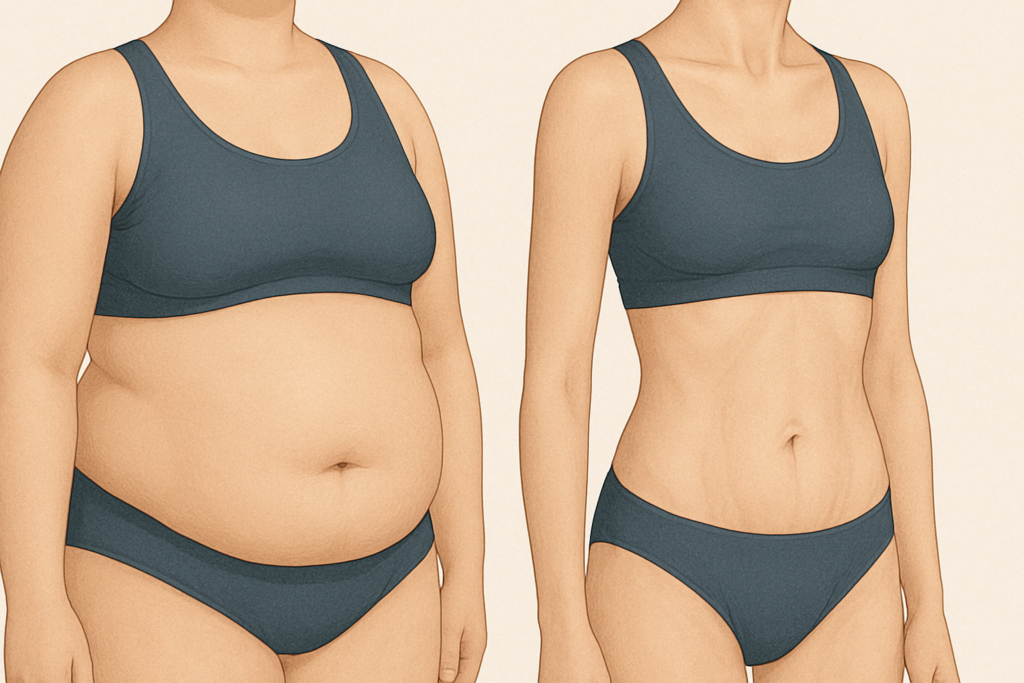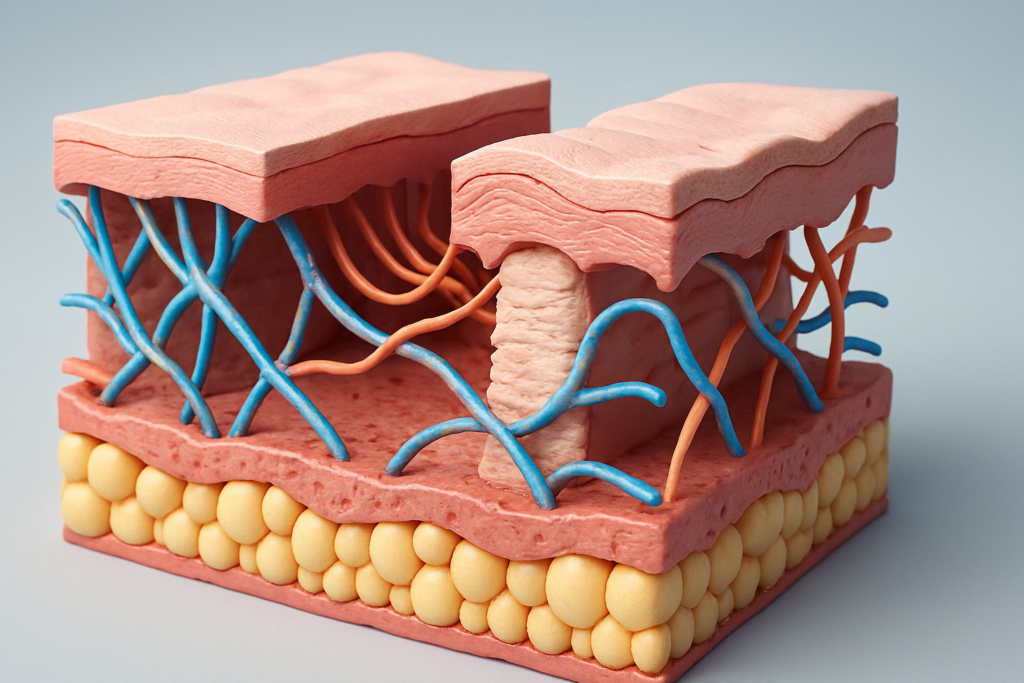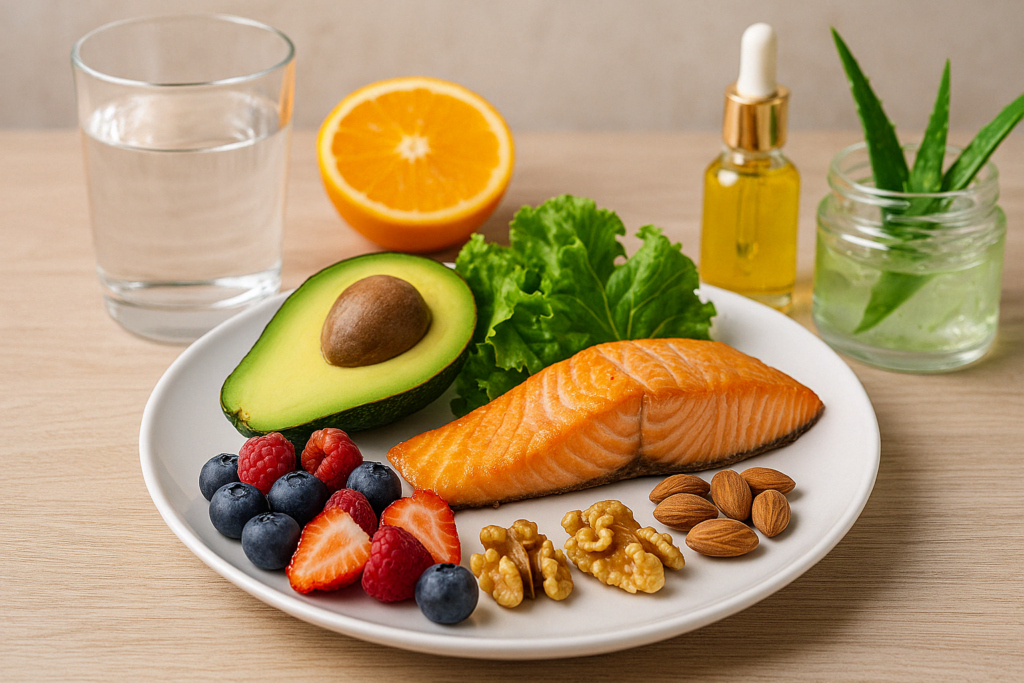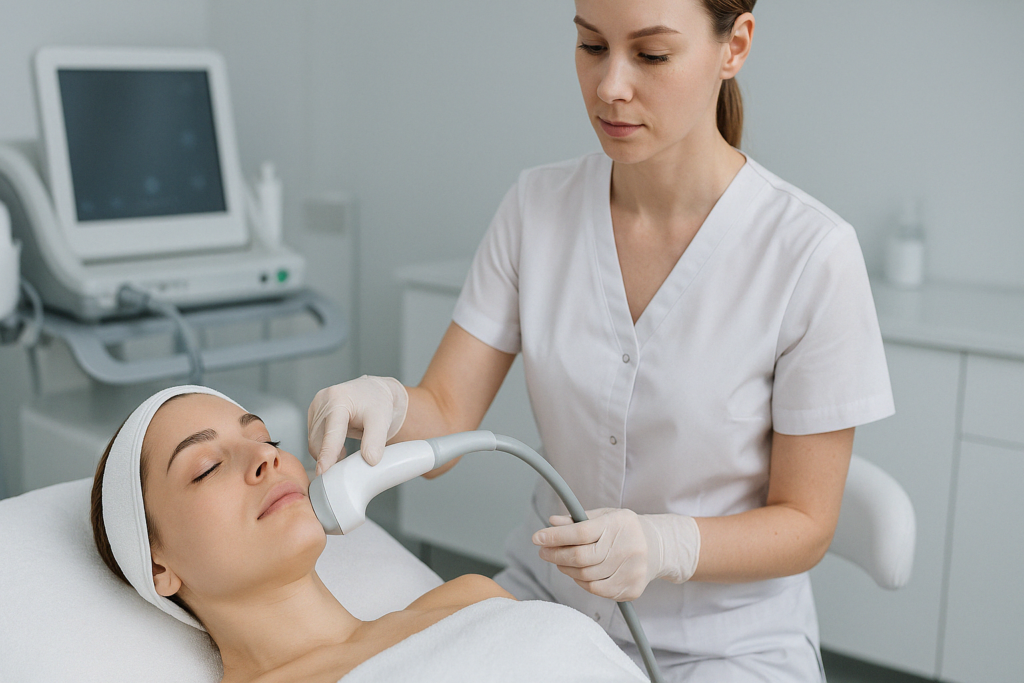Weight loss is often celebrated as a transformative journey, one that requires significant dedication, discipline, and emotional investment. However, for many who succeed in shedding pounds, the physical transformation does not always conclude with a perfectly toned silhouette. Instead, the reality of loose skin after weight loss can present a surprising and emotionally complex challenge. As the body shrinks, the skin may not immediately follow suit, especially after substantial weight loss. This article explores how to tighten loose skin after weight loss using scientifically grounded strategies, with a particular focus on natural, noninvasive, and evidence-based solutions that promote both physical and psychological well-being.
You may also like: The Best Laser Treatments to Tighten Under Eye Skin: What Works for Wrinkles and Sagging Around the Eyes

Understanding the Causes of Loose Skin After Weight Loss
To address the issue of tightening skin after weight loss, it’s essential to first understand why this condition occurs. Skin is a dynamic organ, rich in collagen and elastin—proteins responsible for its elasticity and firmness. When the body gains weight, skin stretches to accommodate the increase in size. If the weight gain is rapid or sustained over a long period, the skin may become overly stretched, resulting in diminished elasticity. Once the weight is lost, especially if the weight loss is rapid or extreme, the skin may not retract completely, leaving behind what is commonly described as flabby skin after weight loss.
Factors influencing the likelihood and severity of loose skin include the amount of weight lost, the duration over which the weight was carried, age, genetics, sun exposure, and lifestyle habits such as smoking or hydration levels. For individuals who have experienced weight gain over many years, or who lose more than 100 pounds, the risk of developing loose stomach skin and sagging in other areas such as the arms, thighs, or face increases considerably. Recognizing these contributing factors allows us to develop realistic expectations and target the most effective strategies for how to tighten skin after weight loss naturally.

The Role of Collagen and Elastin in Skin Recovery
At the cellular level, the condition of the skin after weight loss depends heavily on the health of the connective tissue, particularly collagen and elastin fibers. Collagen provides structural support, while elastin offers flexibility and the ability to bounce back after stretching. As we age, natural production of these proteins declines, and with it, the skin’s capacity to regain tightness after being stretched. This biological reality is central to understanding why younger individuals often experience less sagging skin after weight loss compared to older adults.
Scientific studies have shown that improving collagen synthesis through lifestyle interventions, diet, and targeted treatments can significantly support skin tightening. These findings inform many of the current strategies recommended by dermatologists and nutritionists for how to shrink skin after weight loss. Nutrients such as vitamin C, zinc, and protein all contribute to collagen production, while proper hydration helps maintain skin suppleness. Skin elasticity is not merely a cosmetic concern but a marker of underlying tissue health, making this an important area of focus for long-term well-being.
How to Prevent Loose Skin When Losing Weight
One of the most effective ways to manage this issue is to prevent loose skin during the weight loss process rather than solely addressing it afterward. Understanding how to avoid loose skin when losing weight involves a strategic, gradual approach to weight reduction. Rapid weight loss may result in a more dramatic contrast between fat loss and skin elasticity, increasing the likelihood of sagging skin. Gradual weight loss allows the skin time to adjust and may enhance the body’s ability to regenerate collagen and elastin.
Strength training plays a pivotal role in maintaining skin tautness during weight loss. As fat stores are reduced, lean muscle mass can provide structure beneath the skin, thereby minimizing the appearance of sagging. Consistent resistance training supports skin integrity by stimulating growth hormone and promoting circulation, which delivers nutrients essential for collagen maintenance. This principle holds especially true for how to tighten skin on abs, as abdominal skin is particularly vulnerable to sagging after weight loss.

How to Tighten Skin After Weight Loss Naturally
Many individuals are understandably hesitant to pursue surgical procedures and prefer to explore how to tighten skin after weight loss naturally. This approach aligns with a holistic health philosophy and often involves a combination of dietary support, physical activity, and topical treatments. A high-protein diet is essential for tissue repair and collagen formation, while antioxidant-rich foods—such as berries, leafy greens, and citrus fruits—combat free radical damage that impairs skin health.
Hydration remains one of the simplest yet most effective tools in natural skin tightening. Water not only improves skin elasticity but also supports cellular repair and overall metabolism. Dry, dehydrated skin is less resilient and more prone to sagging. Meanwhile, natural remedies to tighten skin, such as firming masks made from ingredients like egg whites, aloe vera, and coffee grounds, have gained popularity for their mild astringent and antioxidant properties. While the evidence for their efficacy is largely anecdotal, these practices support a proactive, noninvasive skin care routine that complements broader health goals.
The Psychological Impact of Sagging Skin After Weight Loss
The emotional impact of sagging skin after weight loss should not be underestimated. Many people embark on weight loss journeys with the hope of feeling more confident in their bodies, only to find themselves battling disappointment and self-consciousness due to persistent loose skin. This phenomenon underscores the importance of addressing both physical and psychological aspects when considering how to avoid saggy skin after losing weight.
Studies in body image psychology have shown that individuals who experience significant changes in their body shape may struggle with identity integration, especially when the external appearance does not match their internal sense of achievement. A supportive community, mental health counseling, and positive body image reinforcement are all vital tools in this transition. Addressing the emotional toll of flabby skin after weight loss helps create a more compassionate and sustainable path toward wellness.

Non-Surgical Options for Loose Skin
For those seeking more targeted interventions without undergoing surgery, several nonsurgical options for loose skin have demonstrated promising results. These include treatments such as radiofrequency therapy, ultrasound therapy, and laser treatments. Each of these modalities works by stimulating collagen production in the deeper layers of the skin, gradually improving skin firmness and texture.
Radiofrequency treatments use controlled heat to penetrate the skin and stimulate fibroblast activity, promoting the synthesis of new collagen fibers. Ultrasound therapy, such as Ultherapy, targets specific skin depths and is often used to tighten face skin and lift sagging areas. Laser resurfacing, another popular method, improves surface texture and encourages regeneration. These procedures are typically safe, minimally invasive, and require little to no downtime. They represent an important advancement in how to tighten stretched stomach skin and improve overall skin tone.
Supplements to Tighten Skin After Weight Loss
In addition to external treatments, nutritional supplementation can enhance internal skin support mechanisms. Supplements to tighten skin after weight loss often include collagen peptides, hyaluronic acid, and vitamins that support connective tissue health. Collagen peptides, derived from bovine or marine sources, are hydrolyzed forms of collagen that can be absorbed by the body and used to reinforce dermal layers. Clinical studies have demonstrated improvements in skin elasticity and hydration with consistent collagen supplementation.
Hyaluronic acid is another vital component, known for its ability to retain water and keep skin plump and moisturized. Vitamins such as A, C, E, and B-complex all play crucial roles in skin regeneration and repair. Omega-3 fatty acids, found in fish oil, can also reduce inflammation and promote skin resilience. Understanding how these supplements contribute to tightening skin after weight loss allows individuals to make informed decisions based on scientific evidence and personal health goals.

Targeting Specific Problem Areas: Face, Abs, and Stomach
Different areas of the body respond uniquely to weight loss, and understanding how to tighten face skin, how to tighten skin on abs, and how to tighten stretched stomach skin requires tailored strategies. Facial skin, due to its thinner dermis, often shows the earliest signs of sagging. Facial yoga, facial massage, and the best facial skin tightening treatment options such as microneedling or retinoid-based topical agents can promote blood flow and skin renewal. These methods also offer relatively fast results for those seeking how to tighten face skin instantly.
The abdominal region poses a distinct challenge, particularly for individuals who have experienced pregnancy or central obesity. Loose stomach skin can be addressed through a combination of core-strengthening exercises, collagen-stimulating treatments, and supportive garments that reduce tension on healing tissues. For individuals looking to understand how to shrink skin after weight loss in this region, a combination of muscle toning and hydration, alongside external therapies, offers a multi-pronged solution.

The Role of Hormones, Sleep, and Stress in Skin Recovery
Beyond physical treatments, lifestyle factors such as hormone regulation, sleep hygiene, and stress management profoundly affect the body’s ability to regenerate healthy skin. Cortisol, the primary stress hormone, has been linked to collagen breakdown and delayed wound healing. Chronic stress also interferes with immune function and nutrient absorption, both of which are vital for skin repair. Ensuring adequate rest and practicing relaxation techniques like mindfulness, yoga, or deep breathing can significantly enhance skin rejuvenation.
Hormonal fluctuations—especially related to thyroid function, estrogen, and testosterone—can influence skin tone and elasticity. Consulting with a healthcare provider to assess hormonal balance may uncover hidden contributors to skin laxity. Additionally, the restorative effects of deep sleep allow the body to engage in cellular repair, including the synthesis of collagen and elastin. The relationship between sleep and how to prevent loose skin during weight loss is well documented in clinical literature, reinforcing the need for a well-rounded approach.
When Surgery Becomes a Consideration
In cases where natural and nonsurgical efforts prove insufficient, some individuals may consider surgical options such as body contouring or skin removal procedures. These surgeries, often performed by board-certified plastic surgeons, involve excising excess skin and tightening the underlying tissue to achieve a more toned appearance. While effective, these procedures come with risks, recovery time, and significant financial costs.
It’s crucial to approach surgical intervention as a last resort after exhausting other evidence-based strategies for how to avoid loose skin after weight loss. Medical consultation, psychological readiness, and a clear understanding of the benefits and limitations of surgery are essential. For some, the improvement in mobility, hygiene, and self-esteem may outweigh the potential drawbacks, making surgery a reasonable and empowering choice.
Frequently Asked Questions: How to Tighten Loose Skin After Weight Loss
1. Can building lean muscle help reduce loose skin after weight loss, and if so, how?
Yes, building lean muscle is one of the most effective natural strategies for addressing loose skin after weight loss. When fat is lost, the volume beneath the skin decreases, which can leave skin saggy or deflated. By increasing muscle mass through resistance training, you replace some of that lost volume with firm, supportive tissue. This is particularly useful for areas like the abdomen, thighs, and arms, where loose stomach skin and flabby skin after weight loss tend to be most noticeable. Regular strength training not only tones the body but also enhances circulation, which supports skin elasticity and helps with tightening skin after weight loss.
2. How can intermittent fasting impact skin elasticity during weight loss?
Intermittent fasting may support metabolic efficiency and fat reduction, but its effects on skin elasticity are more complex. While some research suggests that short fasting periods can stimulate autophagy—a process that helps remove damaged cells and support collagen turnover—prolonged fasting or rapid weight loss may increase the risk of sagging skin after weight loss. To avoid loose skin when losing weight through fasting, it’s critical to maintain adequate hydration, consume enough protein, and include nutrient-dense foods during eating windows. Combining intermittent fasting with resistance training and collagen-supportive nutrients may enhance its benefits while mitigating the risk of flabby skin after weight loss.
3. Are there specific nutrients that directly influence how to tighten skin after weight loss naturally?
Yes, certain nutrients play a direct role in how to tighten skin after weight loss naturally. Vitamin C is essential for collagen synthesis, while zinc supports wound healing and protein metabolism. Copper helps with the cross-linking of collagen and elastin, and omega-3 fatty acids reduce inflammation and help maintain skin barrier function. Additionally, amino acids like proline, lysine, and glycine—found in bone broth and animal protein—are building blocks of collagen. These nutrients are vital for maintaining skin elasticity and should be a central part of your diet if you’re focused on how to shrink skin after weight loss or avoid saggy skin after losing weight.
4. What is the role of skin brushing and massage in natural skin tightening?
Dry brushing and therapeutic massage are noninvasive techniques that stimulate lymphatic flow and improve circulation, which may promote tighter skin over time. While these methods won’t produce dramatic changes alone, they can complement a broader regimen for how to tighten skin after weight loss. Brushing the skin with a natural bristle brush in upward strokes before showering may improve cell turnover and temporarily enhance skin firmness. Massage therapies using oils like rosehip, frankincense, or vitamin E can also support skin hydration and stimulate fibroblast activity. These practices, when combined with other natural skin tightening strategies, may gradually improve the texture and appearance of loose skin after weight loss.
5. How does age influence your ability to tighten saggy skin after weight loss?
Age is a critical factor in determining how the skin responds after weight loss. Younger skin tends to have more abundant collagen and elastin, making it more resilient and responsive to natural skin tightening strategies. As we age, the body’s collagen production slows, and skin loses its natural elasticity, which can make sagging skin after weight loss more pronounced. Older individuals may find that while they can still benefit from methods like strength training and nutrient support, progress may be slower and less dramatic. For this group, nonsurgical options for loose skin or even medical interventions may become more relevant if natural approaches are insufficient.
6. Can lifestyle habits like alcohol consumption and smoking worsen loose skin after weight loss?
Absolutely—smoking and excessive alcohol consumption are known to damage skin health and impair its ability to recover. Smoking reduces blood flow and oxygen to the skin, accelerates collagen breakdown, and diminishes skin’s ability to regenerate. Alcohol, especially when consumed frequently, dehydrates the body and reduces nutrient absorption, both of which are crucial for healthy skin. If you’re wondering how to prevent loose skin during weight loss, avoiding these substances is essential. Prioritizing lifestyle changes can significantly improve your body’s response to skin-tightening interventions and enhance long-term outcomes.
7. Is it possible to tighten face skin instantly without surgery?
While instant results are limited, some treatments and tricks can temporarily enhance facial firmness. Topical agents like caffeine-based creams or hyaluronic acid serums can provide a short-term plumping effect, while cold therapy—such as facial ice rollers or cryo sticks—can reduce puffiness and temporarily tighten face skin. Certain devices using microcurrent or LED light therapy offer low-level stimulation that can improve circulation and muscle tone in the face. These techniques won’t offer permanent results but can be useful for events or quick boosts in appearance. For longer-lasting results, the best facial skin tightening treatment may involve professional-grade procedures that stimulate collagen, such as microneedling or RF therapy.
8. How can hydration strategies be optimized to support skin tightening during weight loss?
Hydration is often underestimated in discussions about how to tighten skin after losing weight, but it plays a fundamental role. Internal hydration ensures that skin cells remain plump and elastic, while external hydration through moisturizers and barrier-repair creams supports skin resilience. Drinking water consistently throughout the day—especially in conjunction with electrolytes like magnesium and potassium—can improve fluid balance and reduce the dull, crepey appearance of loose skin. Herbal teas rich in antioxidants, like green tea or hibiscus, also offer additional skin benefits. Hydrated skin is more likely to respond positively to natural remedies to tighten skin and other tightening interventions.
9. Are there psychological benefits to treating loose skin after weight loss?
Yes, addressing loose skin after weight loss can significantly impact self-image and mental well-being. Many individuals feel conflicted after major weight loss: proud of their achievement, yet discouraged by the persistence of saggy skin after weight loss. Seeking solutions—whether through nonsurgical options for loose skin, supportive clothing, or skincare—can help individuals reclaim a sense of control and comfort in their bodies. Moreover, investing in personal care practices fosters body appreciation and self-respect, reinforcing the psychological value of maintaining health and appearance. Understanding how to avoid loose skin after weight loss or how to improve it can ultimately support both physical and emotional resilience.
10. What innovations are emerging in the field of skin tightening that show promise?
New technologies and therapies are being developed to offer less invasive yet highly effective solutions for tightening skin after weight loss. Fractional radiofrequency microneedling, for example, combines thermal stimulation with skin resurfacing to enhance collagen remodeling with minimal downtime. Peptide-based skincare products are also gaining traction for their ability to signal the skin to repair itself at a molecular level. Bio-stimulatory injectables like Sculptra are emerging as injectable options for gradual volume restoration and skin firmness. As scientific understanding evolves, personalized plans that integrate lifestyle, nutrition, and high-tech solutions may redefine how to tighten stretched stomach skin and other areas naturally and safely. These innovations may soon become more accessible and customizable, giving individuals a broader range of tools to tighten saggy skin after weight loss without surgery.
Final Thoughts: Embracing a Holistic Approach to Tightening Skin After Weight Loss
Understanding how to tighten loose skin after weight loss requires a multifaceted approach that respects both the biology of skin recovery and the emotional journey of transformation. Whether you’re exploring natural remedies to tighten skin, considering nonsurgical options for loose skin, or seeking the best skin tightening treatments for face and body, it’s essential to focus on solutions that support your physical and psychological well-being.
Adopting sustainable habits like strength training, proper nutrition, hydration, and consistent skincare lays the foundation for long-term results. Meanwhile, advances in dermatological science offer new possibilities for those seeking targeted interventions. Above all, practicing patience, compassion, and body acceptance throughout this process ensures that tightening skin after weight loss becomes not just a cosmetic goal, but a celebration of health, perseverance, and self-respect.
Loose skin after weight loss may pose unexpected challenges, but it is also a testament to your success, your resilience, and your journey toward health. With the right strategies, knowledge, and mindset, it is entirely possible to tighten saggy skin after weight loss and feel confident in the body you’ve worked so hard to reclaim.
Further Reading:
How to Tighten Loose Skin After Weight Loss